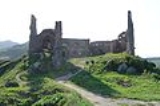
Cetatea Deva
Encyclopedia
The Fortress of Deva, in , is located in the city of Deva
, Hunedoara County
, Romania
, on top of a volcanic hill.
. From the foot of the hill Deva city spreads out, beginning with Magna Curia
and the public park. Nearby are located the lower funicular station (which is used by tourists to reach to fortress), and buildings of the most administrative institutions of the city: The Court House, The Prefecture, The County Hall, The Finance Administration, the old Police headquarters, The City Hall and two of the most oldest schools from Deva: Colegiul Național "Decebal" and Liceul Pedagogic.
, King of Hungary
and Duke
of Transilvania, mentioned "the royal castle of Deva" in a privilege-grant for the Count
Chyl of Kelling
.
From 1273 dates the first record about a military operation that involved The Fortress. Under its walls, the cumans
are defeated by Petrus Chak , who is rewarded for his victory by Ladislaus IV, King of Hungary. In his letter, Ladislaus IV mentioned the facts with the words: sub castro Dewa contra Cumanorum exercitur viriliter dimicavit.
At the end of the 13th century, The Deva Fortress is in the property of Ladislaus Kán, Voivode of Transylvania, who organised here a court besides the military garrison.
Deva, Romania
Deva is a city in Romania, in the historical region of Transylvania, on the left bank of the Mureș River. It is the capital of Hunedoara County.-Name:...
, Hunedoara County
Hunedoara County
Hunedoara is a county of Romania, in Transylvania, with its capital city at Deva.-Demographics:In 2002, it had a population of 485,712 and the population density was 69/km².*Romanians - 92%*Hungarians - 5%*Romas - 2%*Germans under 1%....
, Romania
Romania
Romania is a country located at the crossroads of Central and Southeastern Europe, on the Lower Danube, within and outside the Carpathian arch, bordering on the Black Sea...
, on top of a volcanic hill.
Position
The Fortress is located on a top of a volcanic hill, one of the last branches of Poiana Ruscă MountainsPoiana Rusca Mountains
The Poiana Ruscă Mountains are a Carpathian mountain range in western Romania. Its highest summit is the Padeş, at 1,382 m. The Poiana Ruscă Mountains are situated roughly south of the river Mureş, northeast of the river Timiş and west of the river Strei...
. From the foot of the hill Deva city spreads out, beginning with Magna Curia
Magna Curia
Magna Curia or The Bethlen Castle is a palace located in Deva, Romania.-History:In 1582 the hungarian captain Ferenc Geszty, in charge with the Deva Castle's garrison, erected a house at the foot of the citadel hill...
and the public park. Nearby are located the lower funicular station (which is used by tourists to reach to fortress), and buildings of the most administrative institutions of the city: The Court House, The Prefecture, The County Hall, The Finance Administration, the old Police headquarters, The City Hall and two of the most oldest schools from Deva: Colegiul Național "Decebal" and Liceul Pedagogic.
History
The first evidence of the medieval Deva Fortress dates back to the second half of the 13th century, in 1269, when Stephen VStephen V of Hungary
Stephen V , was King of Hungary from 1270 to 1272.-Early years:...
, King of Hungary
King of Hungary
The King of Hungary was the head of state of the Kingdom of Hungary from 1000 to 1918.The style of title "Apostolic King" was confirmed by Pope Clement XIII in 1758 and used afterwards by all the Kings of Hungary, so after this date the kings are referred to as "Apostolic King of...
and Duke
Voivodeship
Voivodship is a term denoting the position of, or more commonly the area administered by, a voivod. Voivodeships have existed since medieval times in Poland, Romania, Hungary, Lithuania, Latvia, Russia and Serbia....
of Transilvania, mentioned "the royal castle of Deva" in a privilege-grant for the Count
Comitatus (Kingdom of Hungary)
A county is the name of a type of administrative units in the Kingdom of Hungary and in Hungary from the 10th century until the present day....
Chyl of Kelling
Câlnic, Gorj
Câlnic is a commune in Gorj County, Romania. It is composed of nine villages: Câlnic, Câlnicu de Sus, Didileşti, Găleşoaia, Hodoreasca, Pieptani, Pinoasa, Stejerei and Vâlceaua....
.
From 1273 dates the first record about a military operation that involved The Fortress. Under its walls, the cumans
Cumans
The Cumans were Turkic nomadic people comprising the western branch of the Cuman-Kipchak confederation. After Mongol invasion , they decided to seek asylum in Hungary, and subsequently to Bulgaria...
are defeated by Petrus Chak , who is rewarded for his victory by Ladislaus IV, King of Hungary. In his letter, Ladislaus IV mentioned the facts with the words: sub castro Dewa contra Cumanorum exercitur viriliter dimicavit.
At the end of the 13th century, The Deva Fortress is in the property of Ladislaus Kán, Voivode of Transylvania, who organised here a court besides the military garrison.

